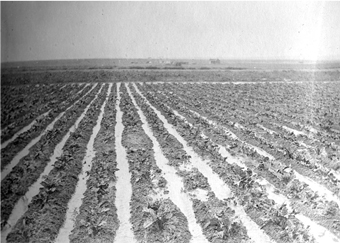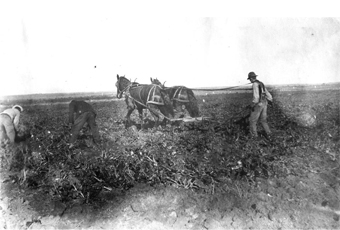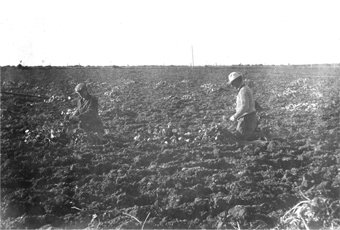G2076
Sugarbeet Production in Nebraska: An Abbreviated History
The establishment of sugarbeet production in western Nebraska enabled the growth of towns and cities in the region.
Robert M. Harveson, Extension Plant Pathologist
- Introduction
- Geography and Climate
- Irrigation
- Sugarbeets Begin in Nebraska
- Social and Economic Influences
- Summary
Introduction
Nebraska’s Panhandle is in the far western portion of the state and plays a major role in the state’s agricultural economy. The Panhandle is noted for specialty crops — field crops grown directly for food (animal and human) or oils. One of the specialty crops with the greatest significance to the state economy is sugarbeets. Approximately 90 percent of the sugarbeets grown in Nebraska are produced in the Panhandle. Most production occurs in Scotts Bluff, Morrill, and Box Butte counties, but acreage is increasing in Sheridan, Banner, Kimball, Cheyenne, Chase, Keith, and Perkins counties. Nebraska currently ranks sixth in the U.S. in production and generally ranges between 45,000-60,000 acres planted per year, with a high of 80,000 in 2000. Sugarbeets contribute economically through both the production and processing industries, and are estimated to contribute more than $130 million to the local economy through payrolls, property taxes, and other impacts.
Geography and Climate
Sugarbeets have been successfully produced in Nebraska for over 100 years. This is due, in part, to a number of environmental factors characteristic of the western part of the state. Sugarbeets need long days (approximately 140 growing days) with sunshine and abundant moisture during the season. This region typically produces an average of 135-160 clear days per year, which is ideal for sugarbeets. The elevation ranges from 3,000-5,000 ft, and the resulting hot days and cool nights provide excellent conditions for development and storage of sucrose in the tap roots. The Panhandle, additionally, has a high desert-type semi-arid climate receiving 14-16 inches rainfall per year. This provides an additional advantage for western Nebraska — an arid climate that helps reduce incidence and severity of several important foliar disease problems that traditionally plague the Minnesota-North Dakota and Michigan producers, such as Cercospora leaf spot. Although levels of required moisture in Nebraska are generally deficient for proper plant growth, this problem is solved supplementating with irrigation.
|
Irrigation
In addition to sugarbeets about 700,000 acres of irrigated crops are grown in the Panhandle. Irrigation in Nebraska began in the early 1890s in Scotts Bluff County to augment alfalfa hay production for feeding livestock in winter. This led to development of irrigation in other introduced crops like sugarbeets and, later, dry beans. Early efforts were small, furnished by local capital. After the Reclamation Service was established, dams were built across the North Platte River in Wyoming, thus paving the way for a complex series of canals to be built across Scotts Bluff County.
These canals became the lifeblood of this region and enabled producers to irrigate beets through furrow systems (Figure 1), which still are common in the North Platte Valley of Scotts Bluff and Morrill Counties. With the introduction of the center pivot irrigation systems and the vast quantities of water available from the Ogallala aquifer, the acreage has been able to spread beyond the Valley to the tablelands north and south of the North Platte River. Approximately two-thirds of the production is now irrigated by center pivots.
Sugarbeets Begin in Nebraska
Sugar production in Nebraska began in 1890, with the first factory being established in Grand Island. This was also the second factory to operate successfully in the United States (after the first in Albany, Calif.). Weather related problems yielded low crop levels, and farmers became discouraged with the concept of continuing sugarbeet production. The state of Nebraska then offered a bounty of one cent per pound on sugar produced in Nebraska to encourage the industry to expand. Other factories were then built in Norfolk and Ames, Neb., in 1891 and 1899, respectively. The farmers in the Norfolk area eventually discovered that they received better returns after raising corn and livestock than sugarbeets, and the factory was closed in 1905. The factory in Ames was built by the Standard Beet Company, which soon recognized the potential for the sugarbeet industry in the North Platte Valley.
|
Production began moving west to Scotts Bluff County, due to both the development of irrigation and the expansion of the railroads through western Nebraska. However, the increasingly severe problems with Cercospora leaf spot experienced in eastern Nebraska also encouraged westward migration. By 1900, enough sugarbeets had been raised in the Panhandle to convince farmers that their land was suitable for this crop (Figure 2). It was then determined that a more extensive means of irrigation than that used by early homesteaders was necessary if the crop was going to significantly expand. Thus, the Tri-State Land Company was founded and set out to develop irrigation throughout the Valley.
In 1909, land was acquired, a factory site was secured, and the Great Western Sugar Company bought the factory previously located in Ames and moved it to Scottsbluff. For the 1910 season, 12,000 acres were contracted at $5.00 a ton and the factory was completed in time for the fall crop, (Figure 3) beginning the foundation for sugarbeets becoming the great agricultural industry it is today.
Social and Economic Influences
By 1904-1905, contract acres from the Standard Beet Sugar Company for sugarbeets approached 300. However, many of the farmers in Scotts Bluff County were unfamiliar with the process of sugarbeet production. In order to fulfill the high potential for this area, efforts were made to recruit help from more experienced growers. It was at this time that the German-Russians (referred to as “beeters”) from Lincoln and Omaha were enticed to come to the North Platte Valley. These workers first came to the Panhandle seasonally in spring at planting, and returned in the fall after harvest. Their experience with sugarbeets dated back to their time in Europe, and was also essential in the initial efforts to produce beets in eastern Nebraska.
By 1924, two-thirds of the sugarbeet workers in Scotts Bluff County were German-Russians. Housing for the workers was first furnished by the growers. In the early years, they were sometimes quartered in tents. By the 1910s, they were housed in two- or three-room shacks or perhaps railroad cars. By the 1930s Great Western furnished housing that consisted of more substantial barracks-like dormitories and houses. As they became more Americanized, they began to find other jobs that would sustain them for the entire year, and their numbers decreased in sugarbeet fields. As the number of German-Russian workers began to decline, much of the slack was taken up by Mexican and Japanese laborers. Many also settled in the Scottsbluff area and became landowners after saving their money to buy land. Today much of the land in Scotts Bluff County is owned by second and third generation descendents of the original German-Russian “beeters.”
In 1905, the acreage planted was less than 300, with yields of seven tons per acre. By the late 1920s to early 1930s, farmers in the Valley were growing up to 80,000 acres with yields of 12 tons per acre. As the volume of sugarbeet production increased over the years, it became apparent that greater processing capacity was needed. This led to the construction of more factories, including those at Gering (1916), Bayard (1917), Mitchell (1920), Minatare (1926), and Lyman (1927). There were additional beet dumps established in McGrew and Melbeta near the railroads for easy transportation to Scottsbluff or Minatare for processing, similar to the process in place today. In fact, “Melbeta” translates as “sweet beet” in German.
Summary
Irrigation was the major factor in the establishment of the sugarbeet industry in western Nebraska. Secondly, the railroads were likewise very influential as they provided transportation to move the beets from field to factory and then to market. Furthermore, they allowed coal to be brought into the area to furnish fuel for operating the factories. In turn, sugarbeets were directly responsible for the immigration and settling of descendents for many of the county’s current residents. Thus sugarbeets were not only responsible for the ethnic makeup of western Nebraska, but also for the economic development and improvement of the area.
The cultivation of sugarbeets enabled the development of roads, expansion of railroads, improvement of schools, and growth and spatial arrangement of cities and farms in Scotts Bluff County. The number of farms increased from 421 in 1900 to 1,391 in 1920. The number of people per square mile in the county increased from 2.6 in 1880 to 28.8 in 1920. The increase in population between 1910 and 1920 was more than 147 percent, one of the highest percentages of population gains in the United States. Therefore, the development of the sugarbeet industry could arguably be the single most important and influential factor in the county, from the building of the sugar factory in 1910 to the present, and has defined Scotts Bluff County as it is known today.
This publication has been peer reviewed.
Visit the University of Nebraska–Lincoln Extension Publications Web site for more publications.
Index: Crop Production/Field Crops
Sugarbeet
Issued May 2011


